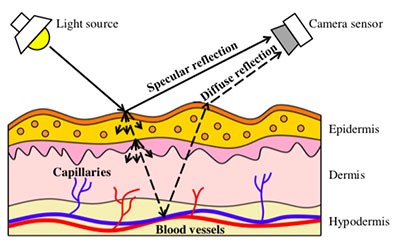Remote photoplethysmography (rPPG) is a technology that can be used in remote patient monitoring (RPM) to monitor patients’ vital signs remotely. The technology uses a camera, typically a smartphone camera, to capture images of a patient’s face and extract information about their heart rate, blood oxygen saturation levels and other biomarkers.
rPPG is non-invasive, easy to use technology which can be done at the patient’s home. This makes it an attractive options for both patient and healthcare provider, as it is convenient and allows healthcare providers to monitor patients’ vital signs remotely, without the need for additional equipment or in-person visits.

One way that rPPG can be used in RPM is by integrating it into a mobile app. Patients can use the app to take a video of their face and then the app will extract information about their heart rate, blood oxygen saturation levels and other biomarkers. This data can then be transmitted to the healthcare provider for review and analysis.
rPPG can also be used to monitor patients with chronic conditions such as heart failure, chronic obstructive pulmonary disease (COPD) and sleep apnea. By continuously monitoring these patients, healthcare providers can identify potential complications early on and intervene before they become more serious, which can help to reduce the need for hospitalization and emergency department visits.
By using rPPG in RPM, healthcare providers can improve patient outcomes and reduce costs. However, it’s important to note that rPPG is still a relatively new technology and more research is needed to fully understand its capabilities and limitations. Additionally, the accuracy of rPPG may vary depending on factors such as lighting conditions and skin pigmentation. It’s also important to note that the use of rPPG in RPM may be subject to regulations and guidelines set by relevant authorities. It’s important for healthcare providers to stay up-to-date on the latest regulations and guidelines related to rPPG and RPM, in order to ensure that they are in compliance with the law. Overall, rPPG can be a valuable tool for healthcare providers in their effort to provide remote patient monitoring services, however, it’s important to use it responsibly and in accordance with the law and guidelines. As with any technology, rPPG should be used in conjunction with other diagnostic tools and clinical judgment to provide the best care for patients.
